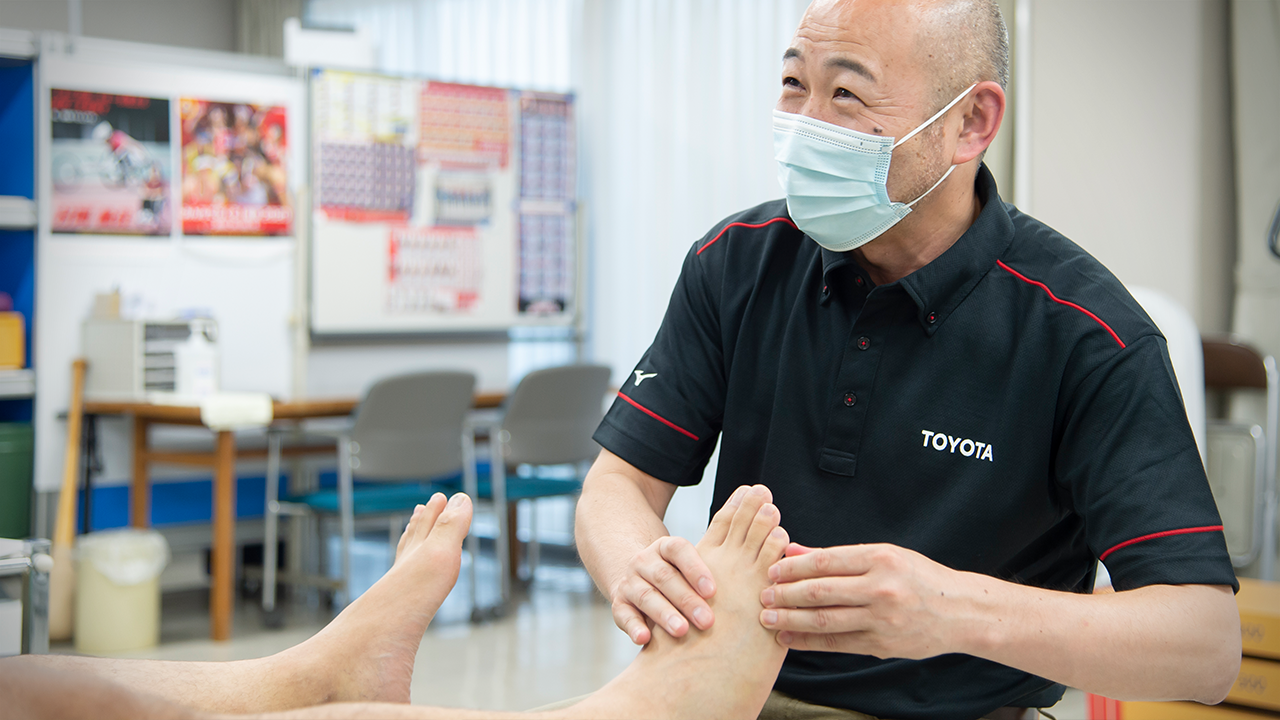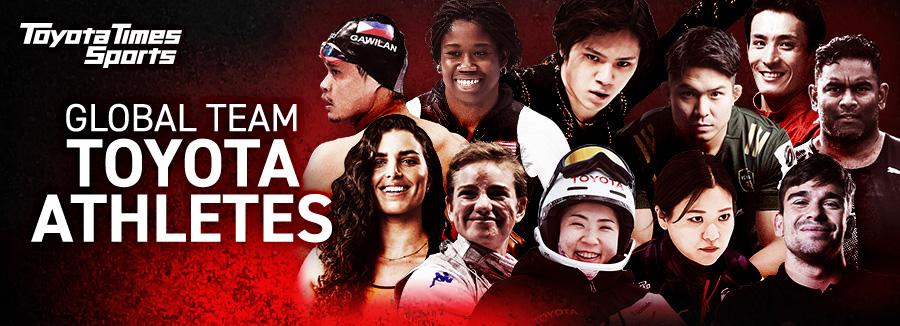
Establishing a Reconditioning Center is almost unprecedented in Japan's sports world. Toyota Times interviews the director on how and why the facility was established, and what role it is expected to play.

Athletes stand on the podium with the crowd cheering and cameras flashing. But they don’t make that happen just by themselves. Various people, from coaches, friends, colleagues, rivals, to families provide them with support, and behind a success or struggle, there are many different stories for each athlete. This athlete series highlights what enables athletes to take on challenges.
What is the Reconditioning Center?
It was in 1973 that the Toyota Sports Center was established on the outskirts of Toyota City in Aichi Prefecture. It is an expansive sports facility with two gymnasiums, three soccer fields, baseball grounds, as well as an athletics stadium and a rugby field. In April 2018, the Reconditioning Center was established on the first floor of a dormitory in one area of this facility, to allow out-of-shape and injured Toyota athletes to recover.
It is Atsuo Okado, Director of the Reconditioning Center, who listens to a brawny rugby player of Toyota Verblitz in the above picture. Okado established the Reconditioning Center transcending the boundaries of various sports, which was almost unprecedented in Japan’s sports world. He was interviewed on how and why the facility was established, and what role it is expected to play.
Okado says the need for this type of facility had always been debated.
Okado
Before this center was opened, the trainers at each competitive sports club had to deal with athletes who had problems, otherwise they had to be diagnosed at medical institutions. On the other hand, there had been discussions about establishing a reconditioning facility in Toyota’s sports facilities for over 10 years to prevent injuries and other problems among athletes, as well as illnesses among employees. That idea came to fruition in April 2018.
Quantifying objective evaluations of athlete conditions
So, what has changed for athletes with the opening of the Reconditioning Center?
There are trainers at every club, and they know their athletes best. We try to perceive the conditions and problems faced by the athletes from functional perspectives based on information we obtain from their trainers.
We are doing our best to try and quantify our athletes’ conditions to grasp a detailed understanding of their current status or any changes resulting from measures implemented. For example, if you’re looking at flexibility, you can quantify it by using a goniometer to measure the angle. This clarifies your target value and allows you to see short or long-term changes. It allows athletes to quantitatively feel the changes, and that seems to give them motivation.
Furthermore, we carry out functional checks once or twice a year at all competitive sports clubs to examine and measure the muscle strength and flexibility of every single athlete. This is also done with the aim of boosting performance and preventing injuries and other problems.
The establishment of the Reconditioning Center has enabled the meticulous accumulation of information on the conditions of individual athletes.
If an athlete claims he has a sore knee, we don’t try to alleviate the pain through palliative treatment. What’s necessary is to identify the problem and the mechanism behind the pain. An athlete may have a sore knee, but muscle strength and flexibility of an athlete differs from person to person. Simply mitigating the pain without addressing its root cause will only lead to a repetitious cycle of pain and treatment.
Even if a person shows signs of physical inflexibility, working in close cooperation with trainers to quantify information on that athlete will allow ascertainment of whether that inflexibility is normal and natural, or a problem for that individual.
In addition to the trainer who sees the athletes every day, Okado adds a third-party perspective, offering the benefits of a second opinion.
An athlete may be in good condition now, but if he suffers repeated injuries or problems during the season, or if he undergoes treatment at the club without much improvement, he has to be examined from a different perspective than those of the various clubs. In other words, we’re not only responsible for the reconditioning of athletes, but we also act as advisors for trainers and coaches. It seems that the athletes, too, sometimes find it easier to say to us things that they have difficulty discussing with the trainers they work with every day (laughs).
Bonds between trainers lead to a growing system
Okado reflects on the establishment of the Reconditioning Center, saying it has grown into a hub that allows the various clubs and their trainers to interact with each other.
When I first came here three years ago, I was surprised to see the trainers of the Sports Center greeting each other by saying, ‘Pleased to meet you.’ This was inevitable in a way, because there was nowhere for the trainers to gather and meet one another. It was such a waste to have professional trainers in various fields all working on their own. So, with here as the gathering spot, we organized meetings for all trainers to exchange information, also enabling study meetings and get-togethers.
The athletes now often ask us questions, and we’ve received comments saying that they not only have more places where they can consult, but they can also be ‘inspired by the athletes of other clubs’ or ‘have more opportunities to connect with them.’ It seems the facility has become a place where communication can come about, and athletes can inspire one another.
Okado says he too has learned a lot from working as the Center’s Director for three years.
I don’t have a 100% understanding of all sports. But the expertise I gained from dealing with the athletes of sports I didn’t have much prior experience in has. This has allowed me to apply it on-site in other sports. I too have gained a lot from this experience.
Continuing to take on challenges with the same high motivation of athletes
In response to a question on whether or not he has any stories to tell about being moved by the recovery of athletes or their achievements, he said without hesitation, “To be honest, whether they’re famous or prominent athletes doesn’t matter to me.”
Regardless of whether or not they’re outstanding athletes being selected as a member of the national team, my attitude towards them is the same. I find joy in seeing all my athletes recover and return to competing.
Okado says he strives to make as much of an effort as his athletes.
The athletes who continue competing here work really hard. So I too take part in workshops, read academic papers, and continue striving to acquire new information in an effort to offer them the best. It’s because I work with the same level of motivation as my athletes that if they don’t adhere to my guidance, I sometimes scold them. There are times when even club trainers and coaches come to me saying, ‘They won’t do as I tell them to, so can you tell them for me instead?’ (laughs)
Toyota has a strong will to protect athletes and employees
Okado was invited to the facility from outside the company three years ago, and he says he sees a culture unique to Toyota, which he was unable to see from the outside.
In establishing the Reconditioning Center, I felt Toyota’s strong will to protect its athletes and employees. I also feel that the cooperation between clubs and trainers to reduce waste and enhance functionality is an initiative unique to Toyota.
No other company in Japan has been taking on challenges like the Reconditioning Center, and people involved in the training industry have also praised our initiative for pursuing the ideal. I feel a sense of responsibility and pressure, but hope to contribute in any way I can to this challenge of establishing and promoting a new model for Japanese sports. Being the first to take on a challenge is perhaps typical of Toyota, too.
According to Okado, the efforts of the Reconditioning Center have only just begun, and he plans to build further on this initiative in the future.
I was on my own until this spring, so there was a limit to what I could do. But I’ve been joined by a new staff member, which has allowed us to provide support to competitive sports clubs outside the Sports Center. I want to gradually expand our reach to support Toyota athletes.
Moreover, Okado has his sights set on a future of supporting not only athletes of sports clubs, but also company employees.
The experience and know-how cultivated through our involvement with top-class athletes can also be applied, for example, to people in general who suffer from pain in their knees or lower backs. The anatomical structure of the body is the same, whether you’re a sturdy athlete or an ordinary employee. So, that’s the kind of area I want to apply my skills to.
So, what have been the benefits and the new issues identified after these three years?
Since I came here, it’s been really good to be able to go and check on the athletes in training immediately after treating them. If they resume running, or pitching for example, I can just walk over to the stadium to see them.
If I were to ask for more, I’d like more space for the Reconditioning Center. Running is the basis of all sports, and it would be great to have enough space for athletes to run as fast as they can. It would also help to have more space for, say, basketball players, so I could watch their moves. The way things are now, I can’t install new equipment because there’s not enough space. I’d like more space as soon as possible. When you publish this article, please make sure the ‘as soon as possible’ part is shown in bold text (laughs).
Okado puts his athletes first, under all circumstances. His vision for the future is to establish an organization in collaboration with various clubs and trainers, centered on the Reconditioning Center. Moving forward, he wants to take the know-how he acquires through this initiative and feed it back to the company employees. Atsuo Okado is taking on unprecedented challenges in supporting athletes behind the scenes. His efforts are also likely to further enrich Japan’s sports culture.
(Text : Takeshi Sato, Photo: Seiga Nagae)

